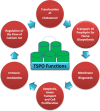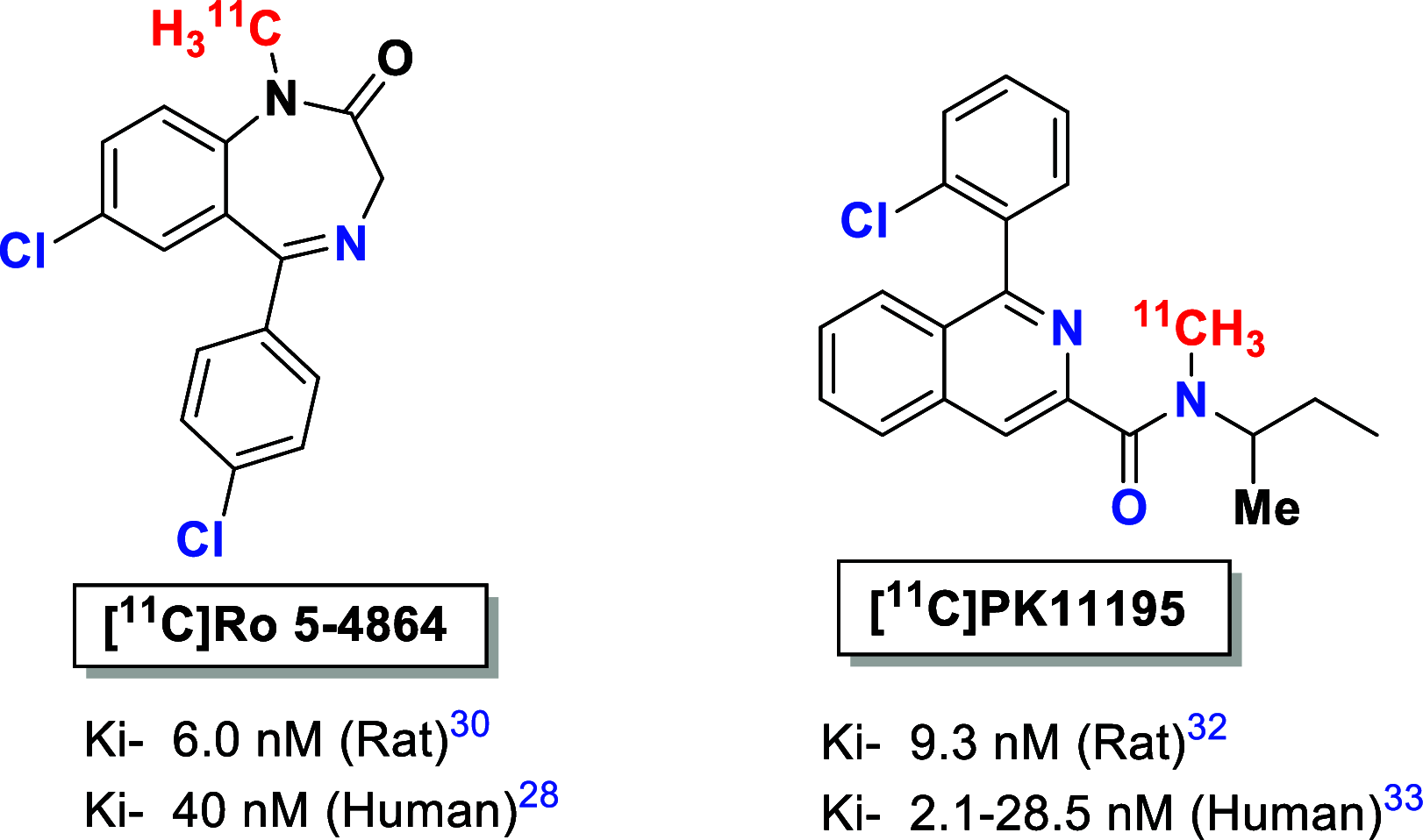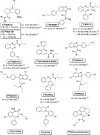The 18-kDa Translocator Protein PET Tracers as a Diagnostic Marker for Neuroinflammation: Development and Current Standing
- PMID: 35557664
- PMCID: PMC9089361
- DOI: 10.1021/acsomega.2c00588
The 18-kDa Translocator Protein PET Tracers as a Diagnostic Marker for Neuroinflammation: Development and Current Standing
Abstract
Translocator protein (TSPO, 18 kDa) is an evolutionary, well-preserved, and tryptophan-rich 169-amino-acid protein which localizes on the contact sites between the outer and inner mitochondrial membranes of steroid-synthesizing cells. This mitochondrial protein is implicated in an extensive range of cellular activities, including steroid synthesis, cholesterol transport, apoptosis, mitochondrial respiration, and cell proliferation. The upregulation of TSPO is well documented in diverse disease conditions including neuroinflammation, cancer, brain injury, and inflammation in peripheral organs. On the basis of these outcomes, TSPO has been assumed to be a fascinating subcellular target for early stage imaging of the diseased state and for therapeutic purposes. The main outline of this Review is to give an update on dealing with the advances made in TSPO PET tracers for neuroinflammation, synchronously emphasizing the approaches applied for the design and advancement of new tracers with reference to their structure-activity relationship (SAR).
© 2022 The Authors. Published by American Chemical Society.
Conflict of interest statement
The authors declare no competing financial interest.
Figures







Similar articles
-
An update into the medicinal chemistry of translocator protein (TSPO) ligands.Eur J Med Chem. 2021 Jan 1;209:112924. doi: 10.1016/j.ejmech.2020.112924. Epub 2020 Oct 14. Eur J Med Chem. 2021. PMID: 33081988 Review.
-
Recent developments on PET radiotracers for TSPO and their applications in neuroimaging.Acta Pharm Sin B. 2021 Feb;11(2):373-393. doi: 10.1016/j.apsb.2020.08.006. Epub 2020 Aug 25. Acta Pharm Sin B. 2021. PMID: 33643818 Free PMC article. Review.
-
18F-Radiolabeled Translocator Protein (TSPO) PET Tracers: Recent Development of TSPO Radioligands and Their Application to PET Study.Pharmaceutics. 2022 Nov 21;14(11):2545. doi: 10.3390/pharmaceutics14112545. Pharmaceutics. 2022. PMID: 36432736 Free PMC article. Review.
-
Current advances in the structure-activity relationship (SAR) analysis of the old/new 18-kDa translocator protein ligands.Mol Divers. 2025 Jun;29(3):2639-2689. doi: 10.1007/s11030-024-10963-0. Epub 2024 Dec 4. Mol Divers. 2025. PMID: 39630364 Review.
-
The translocator protein (18kDa) and its role in neuropsychiatric disorders.Neurosci Biobehav Rev. 2017 Dec;83:183-199. doi: 10.1016/j.neubiorev.2017.10.010. Epub 2017 Oct 18. Neurosci Biobehav Rev. 2017. PMID: 29054730 Review.
Cited by
-
Leptomeningeal metastasis with sturge-weber syndrome-like gyriform calcification on imaging: a case report.BMC Neurol. 2025 Jul 1;25(1):258. doi: 10.1186/s12883-025-04273-7. BMC Neurol. 2025. PMID: 40597070 Free PMC article.
-
Regional neuroinflammation induced by peripheral infection contributes to fatigue-like symptoms: a [18F]DPA-714 positron emission tomography study in rats.Front Immunol. 2023 Nov 9;14:1261256. doi: 10.3389/fimmu.2023.1261256. eCollection 2023. Front Immunol. 2023. PMID: 38022622 Free PMC article.
-
Translocator Protein 18 kDa (TSPO): A Promising Molecular Target for Image-Guided Surgery of Solid Cancers.Adv Pharm Bull. 2024 Mar;14(1):86-104. doi: 10.34172/apb.2024.015. Epub 2023 Oct 14. Adv Pharm Bull. 2024. PMID: 38585455 Free PMC article. Review.
-
Diagnostic utility of plasma translocator protein 18 kDa (TSPO) in sepsis: A case-control study.Medicine (Baltimore). 2024 Nov 1;103(44):e40396. doi: 10.1097/MD.0000000000040396. Medicine (Baltimore). 2024. PMID: 39495982 Free PMC article.
-
Usefulness of Serum Translocator Protein as a Potential Predictive Biochemical Marker of Three-Month Cognitive Impairment After Acute Intracerebral Hemorrhage: A Prospective Observational Cohort Study.Int J Gen Med. 2023 Nov 20;16:5389-5403. doi: 10.2147/IJGM.S438503. eCollection 2023. Int J Gen Med. 2023. PMID: 38021045 Free PMC article.
References
-
- Papadopoulos V.; Baraldi M.; Guilarte T. R.; Knudsen T. B.; Lacapère J. J.; Lindemann P.; Norenberg M. D.; Nutt D.; Weizman A.; Zhang M. R.; Gavish M. Translocator protein (18 kDa): new nomenclature for the peripheral-type benzodiazepine receptor based on its structure and molecular function. Trends Pharmacol. Sci. 2006, 27, 402–409. 10.1016/j.tips.2006.06.005. - DOI - PubMed
-
- Werry E. L.; Bright F. M.; Piguet O.; Ittner L. M.; Halliday G. M.; Hodges J. R.; Kiernan M. C.; Loy C. T.; Kril J. J.; Kassiou M. Recent Developments in TSPO PET Imaging as A Biomarker of Neuroinflammation in Neurodegenerative Disorders. Int. J. Mol. Sci. 2019, 20, 3161.10.3390/ijms20133161. - DOI - PMC - PubMed
Publication types
LinkOut - more resources
Full Text Sources
Miscellaneous

